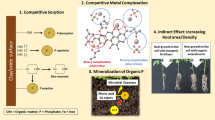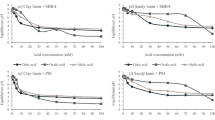Summary
The effectiveness of associating anions in reducing phosphorus retention in soil depends considerably on their physicochemical nature and the conditions under which they react with soil constituents especially the pH of the reaction medium. Organic anions, in general, are found to be superior to inorganic anions and the performance of silicate is best among the inorganic anions and in some cases its performance is comparable to those of organic anions. Organic anions are highly effective in reducing phosphorus retention in soil in an acid medium while the inorganic anions are found to be more effective under slightly acidic to neutral conditions. Citrate, however, is found to be most effective under a neutral condition. The concentration of associating anions should be at least of the same order as that of phosphorus in solution in order to be most effective in reducing phosphorus retention in soil. Higher levels of anion concentration do not exert any remarkable effect on phosphate retention reactions.
Similar content being viewed by others
References
Bray, R. H. and Kurtz, L. T., Determination of total, organic and available forms of phosphate in soils. Soil Sci.59, 39–45 (1945).
Dean, L. A. and Rubins, E. J., Anion exchange in soils. I. Exchangeable phosphorus and the anion exchange capacity. Soil Sci.63, 377–387 (1947).
Deb, D. L. and Datta, N. P., Effect of degree of base saturation and initial phosphate enrichment of soil on the utilization of soil and fertilizer phosphorus by rye. Plant and Soil27, (in press) (1967).
Deb, D. L. and Datta, N. P., Role of associating anions on phosphorus retention in soil: I. Under variable phosphorus concentration. Plant and Soil26, 303–314 (1967).
Dickman, S. R. and Bray, R. H., Colorimetric determination of phosphate. Ind. Eng. Chem. Anal. Ed.12, 665 (1940).
Dickman, S. R. and Bray, R. H., Replacement of adsorbed phosphate from kaolinite by fluoride. Soil Sci.52, 263–273 (1941).
Koening, R. A. and Johnson, C. R., colorimetric determination of phosphorus in biological materials. Ind. Eng. Chem. Anal. Ed.14, 155–156 (1942).
Kurtz, T., De Turk, E. E., and Bray, R. H., Phosphate adsorption in Illinois soils. Soil Sci.61, 111–124 (1946).
Rubins, E. J. and Dean, L. A., Anion exchange in soils. II. Methods of study. Soil Sci.63, 389–397 (1947).
Specht, R. C. and MacIntire, W. H., Fixation, leaching and plant uptake of fluorine from additions of certain fluorides in representative sandy soils. Soil Sci.92, 172–177 (1961).
Struthers, P. H. and Sieling, D. H., Effect of organic anions in phosphate precipitation by iron and aluminium by pH. Soil Sci.69, 205–213 (1950).
Swenson, R. N., Cole, C. V., and Sieling, D. H., Fixation of phosphate by iron and aluminium and replacement by organic and inorganic ions. Soil Sci.67, 3–22 (1949).
Turner, R. C. and Rice, H. M., Role of fluoride ion in the release of phosphate adsorbed by aluminium and iron hydrooxides. Soil Sci.74, 141–148 (1952).
Author information
Authors and Affiliations
Rights and permissions
About this article
Cite this article
Deb, D.L., Datta, N.P. Effect of associating anions on phosphorus retention in soil. Plant Soil 26, 432–444 (1967). https://doi.org/10.1007/BF01379564
Received:
Issue Date:
DOI: https://doi.org/10.1007/BF01379564




